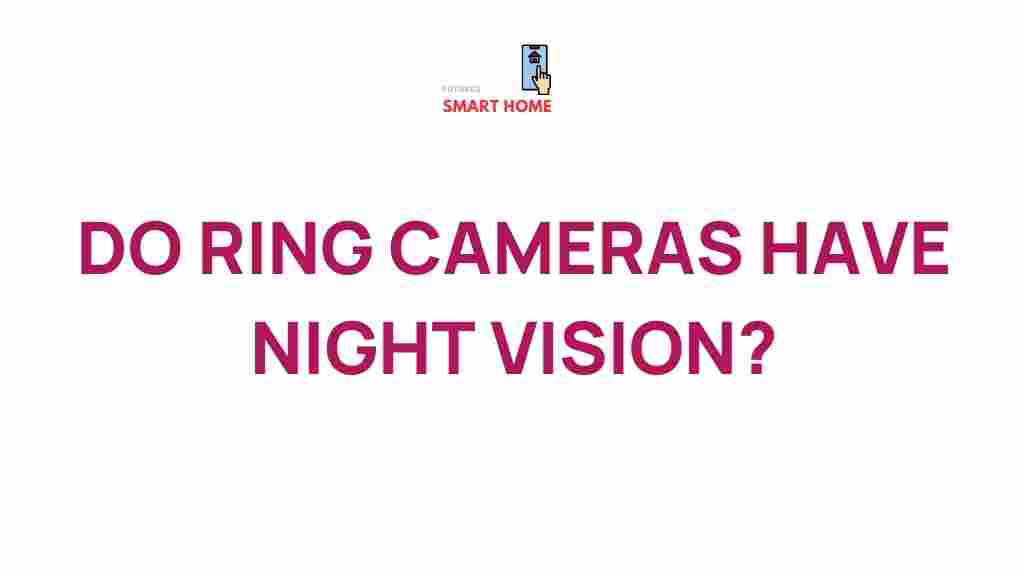Unveiling the Night Vision Capabilities of Ring Cameras
In today’s world, the importance of home security cannot be overstated. With advancements in technology, homeowners now have access to innovative solutions that enhance their security systems. Among these solutions, Ring cameras have emerged as a popular choice. Known for their robust surveillance features, these cameras provide peace of mind and protection for your home. One of the standout features of Ring cameras is their night vision capability, which allows for effective monitoring even in low-light conditions. In this article, we will delve into the night vision capabilities of Ring cameras, exploring how they work, their benefits, and tips for maximizing their performance.
Understanding Night Vision Technology in Ring Cameras
Night vision technology is crucial for surveillance systems, particularly for outdoor security cameras. Ring cameras utilize infrared technology to capture clear images in darkness. Here’s how it works:
- Infrared LEDs: Ring cameras are equipped with infrared LEDs that emit light in the infrared spectrum, which is invisible to the naked eye but can be detected by the camera sensor.
- Image Sensor: The camera’s image sensor converts the infrared light into a visible image, allowing you to see what’s happening outside your home during the night.
- Automatic Activation: Night vision activates automatically when the ambient light drops below a certain threshold, ensuring seamless transitions from day to night.
Benefits of Night Vision in Ring Cameras
The night vision capabilities of Ring cameras offer several significant benefits for home protection and surveillance:
- Enhanced Visibility: Night vision ensures that you can monitor your property clearly, even in complete darkness.
- Deterrence: The presence of a visible camera, even at night, can deter potential intruders.
- 24/7 Monitoring: With night vision, you can keep an eye on your property around the clock, providing continuous security.
- Peace of Mind: Knowing that your home is being monitored at all times can significantly reduce anxiety about potential security threats.
Step-by-Step Guide to Setting Up Your Ring Camera for Optimal Night Vision
To make the most of your Ring camera’s night vision capabilities, follow these steps:
1. Installation
Choose a location that provides optimal coverage of your property. Ensure the camera is mounted at least 9 feet off the ground and facing the area you want to monitor.
2. Adjust Settings
Access the Ring app on your smartphone to adjust the camera settings:
- Navigate to the device settings.
- Enable night vision mode if it’s not already activated.
- Adjust the motion sensitivity settings to reduce false alerts.
3. Test the Night Vision
Once installed and configured, test the night vision feature by monitoring the camera feed in low-light conditions. Make any necessary adjustments to the camera angle or settings.
4. Regular Maintenance
Keep the camera lens clean and free from obstructions to ensure optimal performance. Regularly check for firmware updates through the Ring app to enhance functionality.
Troubleshooting Common Night Vision Issues
Even with advanced technology, you may encounter issues with your Ring camera’s night vision. Here are some common problems and their solutions:
1. Poor Image Quality
If the night vision images appear grainy or unclear:
- Check for dirt or debris on the camera lens and clean it if necessary.
- Ensure that the camera is not facing direct light sources, which can cause glare.
2. Night Vision Not Activating
If the night vision feature does not activate:
- Check the ambient light levels; if there’s too much light, the night vision may not engage.
- Verify that the night vision setting is enabled in the app.
3. Motion Alerts Not Functioning
If you are not receiving motion alerts at night:
- Adjust the motion sensitivity settings in the Ring app.
- Ensure that your camera’s Wi-Fi connection is stable and that it is within range of your router.
Maximizing the Effectiveness of Your Ring Camera
To fully leverage the surveillance capabilities of your Ring camera, consider the following tips:
- Proper Lighting: While night vision works in darkness, having some ambient light can enhance the image quality.
- Regular Updates: Keep your Ring camera’s firmware updated for the latest features and improvements.
- Secure Wi-Fi Connection: Ensure your camera is connected to a strong and secure Wi-Fi network to avoid connectivity issues.
- Use Motion Zones: Customize motion zones within the Ring app to focus on specific areas for monitoring, reducing unnecessary alerts.
Conclusion
In summary, Ring cameras equipped with advanced night vision technology are an invaluable asset for home protection and surveillance. Their ability to provide clear imagery in low-light conditions enhances security and gives homeowners peace of mind. By understanding how to set up and maintain your Ring camera, you can ensure that it performs optimally, safeguarding your property around the clock.
For more information on home security solutions, check out our comprehensive guide on home surveillance technology.
With the right tools and knowledge, you can effectively monitor your home and protect what matters most. Embrace the power of technology and make the most of your Ring camera’s capabilities today!
This article is in the category Reviews and created by FutureSmarthome Team
